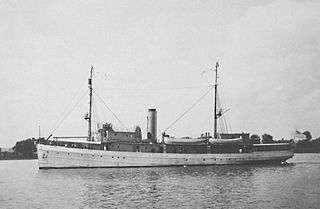
USS Osprey (AM-29) was an Lapwing-class minesweeper commissioned by the United States Navy for service in World War I. She was responsible for removing mines from harbors, and, in her role as rescue and salvage ship, she was responsible for coming to the aid of stricken vessels.
USS Curlew (AM-8) was a Lapwing-class minesweeper acquired by the United States Navy for the dangerous task of removing mines from minefields laid in the water to prevent ships from passing.

The third USS Falcon, (AM-28/ASR-2) was a Lapwing-class minesweeper in the United States Navy. She later became a submarine rescue ship.

The first USS Lark (AM-21) was a Lapwing-class minesweeper in the United States Navy. She was named for the lark.
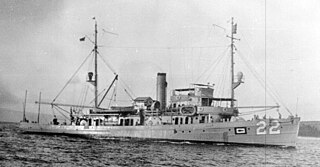
USS Widgeon (AM-22/ASR-1) was an Lapwing-class minesweeper acquired by the United States Navy for the dangerous task of removing mines from minefields laid in the water to prevent ships from passing. Later converted to a submarine rescue ship. Widgeon was named by the Navy after the widgeon, a freshwater duck.

USS Brant (AM-24) was a Lapwing-class minesweeper in the United States Navy during World War II. She was named by the U.S. Navy for the brant, a small goose.

USS Flamingo (AM-32) was a Lapwing-class minesweeper built for the United States Navy near the end of World War I. After service overseas clearing mines after the Armistice, the ship was laid up until 1922 when she was transferred to the United States Department of Commerce for use by the United States Coast and Geodetic Survey. Renamed USC&GS Guide, the ship operated as a survey vessel along the West Coast of the United States for 17 years, making significant contributions to navigation, hydrographic surveying, and oceanography. In June 1941, Guide was transferred back to the Navy, converted into a salvage ship, and renamed USS Viking (ARS-1). As Viking, she worked primarily from bases in California until 1953, when she was sold for scrapping.
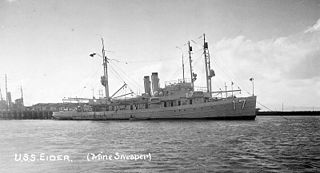
USS Eider (AM-17) was a Lapwing-class minesweeper of the United States Navy.

USS Auk (AM-38) was a Lapwing-class minesweeper acquired by the U.S. Navy after World War I for the task of removing mines that had been placed during the war.
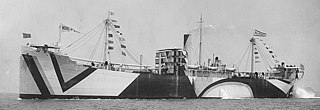
USS Alloway was a United States Navy Design 1015 ship cargo ship in commission from 1918 to 1919 that served during World War I and its immediate aftermath. After decommissioning, she served as the commercial cargo ship SS Alloway until she was wrecked in 1929.

USS James (SP-429) — also known as USS W. T. James (SP-429) — was a steam trawler acquired by the United States Navy during World War I. She was converted into an armed minesweeper and assigned to the European Theater, where she performed varied tasks, including minesweeping, patrolling, and escorting of larger ships in convoy. In 1919, while returning to the United States, she was severely damaged in a storm off the French coast, and sank. Her crew were rescued.

USS Favorite (SP-1385/ID-1385/IX-45) was a large 1223 gross ton tugboat acquired by the U.S. Navy during World War I. She performed a variety of work for the Navy, including icebreaking, salvage, wrecking, and tugboat services. She was loaned to Panamanian authorities after World War I, but was returned to the U.S. Navy to do her part in the Panama Canal area during World War II as the IX-45.

USS Anderton (SP-530), originally to have been USS Raymond J. Anderton (SP-530), was a patrol vessel and minesweeper that served in the United States Navy from 1917 to 1919.
USS Hisko (ID-1953) was a tanker that served in the United States Navy from 1917 to 1919.
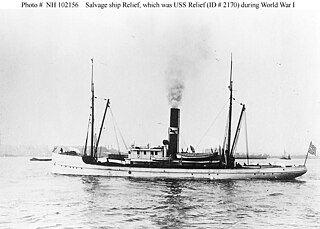
The fourth USS Relief (ID-2170) was a salvage tug that served in the United States Navy from 1918 to 1919.

USS Charles (ID-1298) was a troop transport that served in the United States Navy from 1918 to 1920 and was briefly in commission as USS Harvard in 1918 and 1920. She was better known in her role as passenger liner SS Harvard, one of the premier West Coast steamships operated by the Los Angeles Steamship Company.
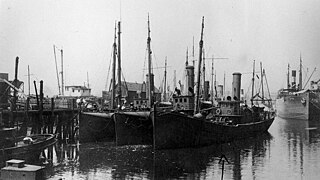
The second USS Ripple (ID-2439) was a United States Navy trawler which served as a minesweeper and was in commission from 1918 to 1919.

USS Berwyn (ID-3565) was a United States Navy cargo ship in commission from 1918 to 1919. She saw service in the final weeks of World War I, then entered commercial service in 1919 as SS Berwyn. She was wrecked in 1920.

USS SC-38, during her service life known as USS Submarine Chaser No. 38 or USS S.C. 38, was an SC-1-class submarine chaser built for the United States Navy during World War I.

USS Western Chief (ID-3161) was a cargo ship of the United States Navy that served during World War I and its immediate aftermath. As SS Western Chief, she was sunk during World War II after being sold to the United Kingdom for use as a merchant ship.


















